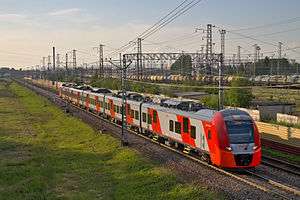Russian Railways
 | |
|
| |
| Reporting mark | RZD, RZhD |
|---|---|
| Locale | Russia |
| Dates of operation | 1992–present |
| Predecessor |
Russian Ministry of the Means of Communication (MPS of Russia) (1992-2004) People's Commissariat/Ministry of the Means of Communication (Soviet Union) (1923–1991) People's Commissariat of the Means of Communication (Russian SFSR) (1917-1923) |
| Track gauge |
1,520 mm (4 ft 11 27⁄32 in) 1,067 mm (3 ft 6 in) (on Sakhalin Island) 1,435 mm (4 ft 8 1⁄2 in) (from Kaliningrad to Russian-Polish border) |
| Electrification | 3 kV DC, 25 kV AC Main |
| Length | 86,000 km (53,000 mi) |
| Headquarters | Novaya Basmanaya 2, Moscow |
| Website | www.rzd.ru |
 | |
| government owned | |
| Industry | rail transport |
| Predecessor |
Russian Ministry of the Means of Communication (MPS of Russia) (1992-2004) People's Commissariat/Ministry of the Means of Communication (Soviet Union) (1923–1991) People's Commissariat of the Means of Communication (Russian SFSR) (1917-1923) |
| Founded | 2003 |
| Headquarters | Moscow, Russia |
Area served | Russia |
Key people |
Oleg Belozerov (President) Arkady Dvorkovich (Chairman of the Board)[1] |
| Revenue |
|
| |
| |
| Total assets |
|
| Owner | Russian Government |
Number of employees | 942,808 (31.12.2011) |
| Parent | Russian Ministry of Transport |
| Subsidiaries |
|
| Website |
www |
|
Footnotes / references JSC Russian Railways Consolidated Financial Statements 2011[2] | |
JSC Russian Railways (JSC RZD; Russian: Российские железные дороги (РЖД) tr. Rossiyskie zheleznye dorogi (RZhD)), is a Russian vertically integrated company, both managing infrastructure and operating freight and passenger train services. In 2012 it became one of the three largest transport companies in the world.[3] The company was established on September 18, 2003, when a decree was passed to separate the railways from the Russian Ministry of the Means of Communication (MPS) (1992-2004, dissolved).
Full name — Open Joint Stock Company Russian Railways with headquarters in Moscow at Novaya Basmannaya str., 2. The operating units of the central part of the staff are at Kalanchevskaya str., 35.[4] Oleg Belozerov has been president of the company since August 20, 2015.[1]
History
JSC Russian Railways was established by Decision № 585 of the Government of the Russian Federation dated September 18, 2003. On October 1, 2003, the company took over the management functions of the rail networks from the Ministry of Railways of the Russian Federation (MR), leaving the state regulation to MR. RZD got 987 companies (95% in asset value) out of the 2046 that had formed the MR system.[5] The reform saw the creation of a new market segment following the privatization of the network's rolling stock. The company divided the bulk of its wagon fleet between two new operating companies, Freight One (which was later privatised) and Freight Two (renamed Federal Freight in 2012), and private players such as GlobalTrans also entering the market.
The reform of the railway sector
In the mid-1990s, the profitability of MR's railage fell down to negative values, which became the reason for reforms. Soon after his inauguration, President Putin approved the idea of the Railway Reform Programme, according to which all business functions on the railway must be transferred to the joint-stock company with 100 per cent state involvement.[6] The reforming of the railway sector in Russia started with the establishment of JSC Russian Railways, October 2003. The new company has received more than 95% of the assets under the Ministry of Transport and Communications of the Russian Federation.[7] On October 28, 2011, the largest[8] privatization transaction in the denationalization of the Russian railway industry took place at an auction held in Moscow. The Joint Stock Company Freight One, a subsidiary of Russian Railways, sold 75% of its shares minus two shares for 125.5 billion rubles (about 4 billion $) to Independent Transport Company owned by Vladimir Lisin. Thus, Lisin as Russia's largest operator of rolling stock got the control of a quarter of the freight market.[9] On October 16, 2012, Russian Railways has completed competitive negotiations with potential buyers of the remaining 25-percent plus 1 share stake in JSC Freight One. The best binding offer was received from the Independent Transport Company LLC. The assets were sold for 50 billion rubles.[10]
Mergers and acquisitions
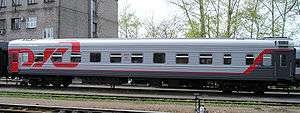
In early November 2012, Russian Railways announced the purchase of 75% of the French logistics company Gefco SA. The total value of the transaction was 800 million euros, the seller being PSA Peugeot Citroen, the parent company of Gefco.[11] On May 23, 2007, Russian Railways adopted a new corporate style which changed fundamentally the way the Company presented itself visually to the outside world. The change of corporate identity underwent several stages during the 2007–2010 period.[12] The final version of the logo was designed by BBDO Branding.[13] Also, commissioned by BBDO Branding The Agency HardCase Design created a family of corporate fonts RussianRail, consisting of 15 fonts. In the new company logo Sans-serif RussianRail Grotesque Medium was used. In 2008, the new logo of Russian Railways became a runner-up for the international design competition WOLDA '08 award.[14]
Owners and management
The Russian Federation is the founder and sole shareholder of JSC Russian Railways. On behalf of its shareholders the powers are exercised by the Government of the Russian Federation.[15] It approves the President of the Company, forms the Board of Directors annually and approves the annual reports.[16] Kirill Androsov is the Chairman of the Board of Directors of JSC Russian Railways from September 2011.[17] Before him, the position was occupied by Alexander Zhukov – from July 20, 2004 to September 2011 and Viktor Khristenko – from October 16, 2003 – July 20, 2004. President of JSC Russian Railways is Vladimir Yakunin – from June 14, 2005, before him — Gennady Fadeev from September 23, 2003 – June 14, 2005.
Structure
Since 2008, as part of the structural reform of rail transport, with separation of the services infrastructure of transportation activity and the emergence of a competitive environment, Russian Railways has been transformed into a vertically oriented holding company.[8]
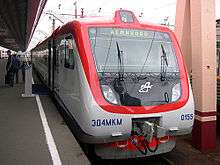
Activities
The main directions of the company's business — freight and passenger traffic. The share of railways in the total turnover of the transport system of Russia is about 42%, in passenger traffic — about 33%[3] In 2013 railways carried nearly 90% of Russia's freight, excluding pipelines.[18][19]
Tariff rates
For the period of monopoly of JSC Russian Railways in the federal transport system the eligibility of rail services at regulated tariffs is guaranteed by the Government and State.
Freight tariffs
The cost of freight tariff is determined by the Federal Tariff Service at net cost or higher.
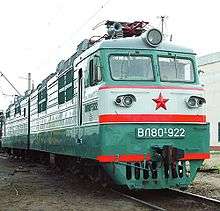
Fares on long distance trains
Passenger tariffs (except for travelling in the stateroom, sleeping and VIP-cars) are approved by the State, represented by the Federal Tariff Service with social orientation of its traffic operations below cost. Passenger fare is divided into two components: «ticket» (which includes the cost of transport infrastructure, locomotive traction and the Station component) and «reserved seat» (service of transport company, which is the owner of the car). Since 2003, the flexible schedule tariffs (FST) to travel on long-distance trains is used:
- in the period of keen demand the rate is above the annual average by 5–20% (earlier it was up to +45%)
- approximately the third part of the year the base rate is active
- during the periods of low passenger's traffic the rate is lower by 5–20%. On certain days of the year (from 1 to 3 days, at different times on such days as 31.12, 01.01 and dates around the 9 May) the index of 45–50% is valid when tickets are twice cheaper.
FST is calculated in such a way as to stimulate passengers to undertake a trip on the date with the lowest index. In 2010 and 2011, the average weighted index for calendar periodswas 0.97 and the average volume of passenger traffic — 1.00. According to the JSC Russian Railways statement, the passenger transportation — except for some highly profitable directions — is unprofitable. These losses are partly compensated from the budget, and for the most part — with the help of cross-subsidies by income from freight. See also The competition and tariff regulation of the rail market and railway assets in Russia.
Suburban passenger complex
Since 2009, the company is not a direct carrier of passengers. The suburban traffics are exercised by the passenger companies founded by the executive agencies of the Russian Federation, Russian Railways and private investors.[20] These are such companies as JSC TSPPK, LLC Aeroexpress, JSC CSPC and so on.[21] By 2012, the number of SPCsin Russia has reached 26. Especially for the SPC a zero tariff for the use of railway infrastructure was introduced. Russian Railways receives 25 billion rubles subsidies as compensation annually from the State.[22] Commuter traffic in the whole network increased in 2011 on 5.6% and is about 878.33 million people.[20] Passenger turnover rail in the Russian regions ranges from 5% to 30% in total passenger traffic.[22]
Performance indicators
Annually JSC Russian Railways carries over 1 billion passengers and 1 billion tons of freight.
| Kind of activity |
Indicator | 2005 | 2007 | 2008 | 2009 |
| Freight traffic |
Freight (trln tn. km). | 1,85 | 2,31 | 2,4 | 2,27 |
| To last year | +3,1 % | +5% | |||
| Freight (bln tn.). | 1,40 | 1,34 | 1,30 | 1,11 | |
| To last year | +4% | ||||
| Passenger's traffic |
Passenger turnover (trl pass. km) | 118,9 | 174,1 | 176 | 153,6 |
| To last year | +3,8 % | +1% | |||
| Passengers (mln pass.) | 1352,8 | 1296 | ~1100 | ||
| To last year | +2,5 % | ||||
| Attendants (ths people) | 1127 | 1099 | 1075 |
In 2011, freight traffic of Russian Railways totaled about 1.4 billion tons. Passenger traffic for the year 2011 reached 992.4 million people.[3]
| Indicators | 2005 | 2006[23] | 2007[24] | 2008[25] | 2009[26] | 2010[27] | |||||
|---|---|---|---|---|---|---|---|---|---|---|---|
| Income | 749 bln rb. | |
877,9 bln rb. | |
1,016 trl rb. | |
1,203 trl rb. | |
1,126 trl rb. | |
1,334 trl rb. |
| Operating cost | 684,7 bln rb. | |
821,5 bln rb. | |
1,089 trl rb. | |
1,013 bln rb. | |
1,135 bln rb. | ||
| Operating income | 194,7 bln rb. | |
194,6 bln rb. | |
113,9 bln rb. | |
113,3 bln rb. | |
198,9 bln rb. | ||
| EBITDA | 267,5 bln rb. | ||||||||||
| Net income | 114 bln rb. | |
139,8 bln rb. | |
144,9 bln rb. | |
76,4 bln rb. | |
121,3 bln rb. | |
208,3 bln rb. |
The average salary on the network in October 2011 — 31 thousand rubles a month.[28] Loading volume for the year 2012 amounted to 1 billion 274.7 million tons (+2.7% compared to 2011), the share in the total turnover of the country (except pipelines) — 85.5%. In 2012, the network carried 1 bln 56.7 million passengers (+6.4% compared to 2011). Net income from the basic activities using Russian GAAP was in 2012 almost 5.3 billion rubles, which is a decrease compared to 2011 (13.7 billion rubles) of almost 3 times.[29]
Infrastructure
As at December 31, 2009, the total operational kilometers of railway is 85 281 km, including the track gauge of 1,520 mm (4 ft 11 27⁄32 in) — 84 446 km, the length of continuous welded rails 74.4 thousand km, the railway network operated by 166 975 switches, 138 tunnels and 30,727 bridges. The length of lines equipped with automatic block (AB) and centralized control, is 62,055 km, or 72.9%. Devices of railway automation and remote control on the Russian railway network served with 203 distance signaling, centralization and blocking and with one technical center of automation and remote control.
Rolling-stock railways
Traction rolling stock includes diesel locomotives, electric locomotives, electric trains, diesel trains, railcars, railway handcar, other self-propelled equipment and non-tractive rolling stock — different cars (passenger, freight) and a special rolling stock. At the end of 2009 the inventory rolling stock of RZD contained 2,101 locomotives, including 209 electric passenger locomotives, 536 diesel passenger locomotives, 417 electric freight locomotives, 350 diesel freight locomotives, 589 movable locomotives. Service life has expired of 796 electric passenger locomotives (18.66%), 523 electric freight locomotives (12.3%), 876 mainline locomotives (20.5%) and 1896 movable locomotives (44.4%).
Investment program
The volume of investment of JSC Russian Railways in 2012 reached 460.1 billion rubles.[30] In 2009, the investment budget was 262.8 billion rubles (excluding VAT), of which:
- 47,4 billion — projects related to the preparation and staging of the Olympic Games in Sochi;
- 58,7 billion — renovation of the rolling stock (including supply of Sapsan [Peregrine] trains ).
Priority is given to the financing of projects that have received targeted funding and support of the Government:[31]
- combined road (highway and rail) Adler-mountain resort «Alpika-Service» — 41.5 billion rubles;
- the purchase of products of JSC «Tver Carriage Works» — 3.0 billion rubles;
- «Construction of a new railway section Yaiva-Solikamsk on Sverdlovsk line bypassing the area of man-made industrial disaster» — 6.0 billion rubles.
For account of the funds received from the additional indexation of freight tariffs by an average of 1% in 2009,the following projects were funded
- «The organization of intermodal transport on the line of Sochi – Adler – Airport "Sochi"»;
- «Strengthening the infrastructure of the railway line Tuapse – Adler»;
- «Organization of freight yards to gain admission to the Olympic construction goods».
The main projects of the Investment program 2012–2014:
- Acceleration to 2014 the passenger traffic on the line Moscow-Adler and the line service between Rostov and Krasnodar to 2015;
- Implementation of the joint project of Siemens AG and the «Ekaterinburg» on delivery and localization of high-speed electric stock;
- Organization of intermodal station on the Kazan-the international airport «Kazan» route
- Speeding up of the development of the railway infrastructure of the Moscow transport hub.
| Rolling stock | 2006 | 2007 | 2009 | 2012 |
|---|---|---|---|---|
| Diesel locomotive | 278 | 319 | 355 | 211 |
| Goods wagon | over 8,5 th | appr 40 th | 8080 (7788 — Freight One | |
| Passenger car (rail) | 738 | 895 | 643 | |
| Electric multiple unit | appr 750 | over 740 | 695 | |
| Investments | over 53 bln rub | over 80 bln rub | 265,7 bln rub | 60,8 bln rub |
The main producer of passenger cars (95%) is «Tver Carriage Works»
Railways
The following Railways belong to RZD:
- Kaliningrad Railway
- October Railway
- Moscow Railway
- Gorky Railway
- South Eastern Railway
- North Caucasus Railway
- Crimea Railway (de facto)
- Volga Railway
- Kuybyshev Railway
- South Urals Railway
- Northern Railway
- Sverdlovsk Railway
- West Siberian Railway
- Krasnoyarsk Railway
- East Siberian Railway
- Trans-Baikal Railway
- Far Eastern Railway
Future projects
According to the 2011 JSC RZD Annual Report:[32] the company plans to invest over 2.2 trillion rubles (about 70 billion dollars) until 2020 to upgrade and expand the network infrastructure (without high-speed and high-speed projects). Seven priority infrastructure development projects were allocated. These are approaches to the ports of the South of Russia, an approach to the ports of the North-West Russia, infrastructure in Western Siberia, and north of the Urals Federal District, Trans-Siberian Railway, Baikal-Amur Mainline, Mezhdurechensk, Abakan – Taishet station, the Moscow railway hub. The company recognizes that it has not sufficient funding for the major projects planned, and the cost of borrowing in the bond market does not allow to implement infrastructure projects with positive financial results and return on investment.[33]
Planned projects
- Project HSM 1 — separate railway line between Moscow and St. Petersburg. The expected speed of HSM 1 is up to 400 km / h, the estimated time en route between Moscow and St. Petersburg will not exceed 2.5 hours. The preparation project for HSM 1 to international tender performed by JSC High-speed highway. Presentation of the project at the international market of infrastructure providers took place in the first half of 2011.
- In plans — reconstruction, electrification and the organization of passenger traffic in the Small ring in Moscow. For this project, on June 23, 2011, Russian Railways jointly with the Moscow government founded CIT, a company with a registered capital of 5 billion rubles. The start of the passenger traffic, as announced by the Moscow government, will be September 2015; the passenger service on Moscow Ring Railway started on September 10, 2016. Total investments are 85.9 billion rubles, of which the share of JSC Russian Railways is 38.5 billion rubles.[34]
- The Trans-Eurasian Belt Development — In March 2015, at a meeting of the Russian Academy of Science, Vladimir Yakunin presented an ambitious new transport route called the Trans-Eurasian Belt Development (TEPR) which would go "through Russia with a mega road and high-speed rail network to link Asia with Europe' and "with the opportunity to go to Chukotka and Bering Strait and then to the American continent"[35] to Alaska, "making overland trips from Britain to the US (via the Channel Tunnel) a possibility."[36]
Subsidies
In total, Russian Railways receives 112 billion roubles (around US$1.5 billion) annually from the government.[37]
High-speed traffic
In 2005–2010, JSC Russian Railways has launched a program to introduce new high-speed trains.[39] The first train launched, Sapsan (peregrine falcon), connects St. Petersburg, Moscow and Nizhny Novgorod. The second train, Allegro, has run from December 2010 from St. Petersburg to Helsinki (Finland) via the city of Vyborg. Peregrine Falcon was the most successful passenger train of JSC Russian Railways with occupancy rate of 84.5% (according to RZD in 2010) and profitability of 30% (although capital costs were not included in its calculation).[40]
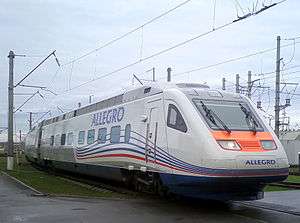
Sponsorship
Since February 2016 Russian Railways is the sponsor of Rodina from Kirov, a team in the Russian Bandy Super League.[43]
References
- 1 2 New head of RZD
- ↑ JSC Russian Railways Consolidated Financial Statements 2011
- 1 2 3 РЖД собираются увеличить свою инвестпрограмму до 460 млрд рублей
- ↑ Contacts, at eng.rzd.ru
- ↑ History at eng.rzd.ru
- ↑ Pr. Putin speaks on the Ministry of Railways of the Russian Federation
- ↑ ОАО "Российские железные дороги" (РЖД). Справка
- 1 2 Reform at eng.rzd.ru
- ↑ RBC Daily:Владимир Лисин занял четверть рынка перевозок по железной дороге
- ↑ Russian Railways to sell Freight One stake to Lisin
- ↑ Russian Railways in Gefco talks, at independent.co.uk
- ↑ О компании at rzd.ru
- ↑ BBDO Branding подрезало крылья РЖД at sostav.ru
- ↑ logo at wolda.org
- ↑ The structure, at eng.rzd.ru
- ↑ Share capital, at eng.rzd.ru
- ↑ Андросов Кирилл Геннадьевич, at rzd.ru
- ↑ Chris Lo (1 May 2013). "Russian railways: connecting a growing economy". railway-technology.com. Retrieved 16 September 2014.
- ↑ Courtney Weaver (17 June 2013). "Russian rail freight proves a worthy investment". Financial Times. Retrieved 16 September 2014.
- 1 2 Пригородные железнодорожные перевозки пассажиров в 2011 году выросли на 5,6%, at press.rzd.ru
- ↑ Пригородная реформа, at expert.ru
- 1 2 Регионы хотят лишить права занижать цену билетов на электрички, at top.rbc.ru
- ↑ Financial performance indicators, 2006
- ↑ Financial performance indicators, 2007
- ↑ Financial performance indicators, 2008
- ↑ Financial performance indicators, 2009
- ↑ Financial performance indicators, 2010
- ↑ Зиму встречаем во всеоружии, at zdr.gudok.ru
- ↑ ОАО "РЖД" в 2012 году увеличило доходы от основной деятельности на 5,8%, at press.rzd.ru
- ↑ Investment Programme, at eng.rzd.ru
- ↑ Strategy, at eng.rzd.ru
- ↑ Annual Report: 2011, at eng.rzd.ru
- ↑ На решение одной российской проблемы РЖД нужно 2,2 трлн руб, at top.rbc.ru
- ↑ Пассажирское движение на Малом кольце Московской железной дороги откроется в 2015 г., at regnum.ru
- ↑ "Plans for new transport route unveiled to link Pacific with Atlantic". The Siberian Times. 23 March 2015. Retrieved 26 March 2015.
- ↑ Smith, Oliver (25 March 2015). "Russia is considering plans for a 12,400-mile superhighway from London to Alaska". The Business Insider. Retrieved 26 March 2015.
- ↑ "Government support for Russian Railways".
- ↑ Russia-trains: Moscow to St Petersburg by train, at seat61.com
- ↑ High-speed trains, at eng.rzd.ru
- ↑ Скорая прибыль «Сапсана», Алексей Непомнящий, at vedomosti.ru
- ↑ "Allegro launch cuts Helsinki – St Petersburg journey times". Railway Gazette International. London. December 13, 2010.
- ↑ "Allegro". VR. Retrieved September 7, 2010.
- ↑ https://translate.googleusercontent.com/translate_c?depth=1&hl=en&prev=search&rurl=translate.google.co.uk&sl=ru&u=http://www.bandyvesti.ru/%3Fp%3D20150&usg=ALkJrhiaZYVq20e7d9_E-1pLs_dOD4DRbQ
In Russian
- Госкомстат СССР (Gov't Statistical Committee ) "Народное хозяйство СССР: статистический ежегодник" (The national economy of the USSR, statistical yearbook),Финансы и статистика, Mосква (various years till 1990).
- Госкомстат СССР (Уманский, Л.) ,"Народное хозяйство СССР за 70 лет: юбилейный статистический ежегодник". Москва, "Финансы и статистика", 1987.
- Госкомстат СССР "Транспорт и связь СССР: Статистический сборник" (USSR Transportation and Communications: statistics). Москва. 1990 (and other editions: 1967, 1972, etc.)
- ЖТ = Железнодорожный Транспорт (Railroad Transportation) a monthly magazine published since 1826. The month designation is numeric; e.g. 10-1998 is the November issue.
- Плакс, А.В. & Пупынин, В.Н., "Электрические железные дороги" (Electric Railroads), Москва, "Транспорт", 1993.
- Резер, С.М., "Взаимодействие транспортных систем", Москва, "Наука", 1985.
- Шадур, Л.А. ed., "Вагоны: конструкция, теория и расчёт" (Railroad cars: construction, theory and calculations), Москва, "Транспорт", 1980.
- Федеральная служба государственной статистики (Federal government statistical service) "Транспорт в России" (Transportation in Russia) (annual) Available online
- Филиппов, М.М. (editor), "Железные дороги. Общий курс" (Railroads, General Course) Москва, Транспорт, 3rd ed. 1981. 4th ed. 1991 with new editor: Уздин, М.М. .
- Шафиркин, Б.И, "Единая транспортная система СССР и взаимодействие различных видов транспорта" (Unified Transportation System of the USSR and interaction of various modes of transportation), Москва, "Высшая школа", 1983.
- Шадур. Л. А. (ed.), "Вагоны" (Railway cars), Moscow, "Транспорт", 1980.
External links
| Wikimedia Commons has media related to OJSC Russian Railways. |
- Russian Railways Official Site (English)
- "Steam and the Railways of Sakhalin Island"
- Russian Railway in 1935
- "A site about railways in C.I.S. and Baltics". Archived from the original on December 4, 2012.
- Rail Fan Europe
- Railroad Transport in Russia (Russian Wikipedia) (Russian)
- Railroad Transport in the Soviet Union (Russian Wikipedia) (Russian)
- "Rail map of former Soviet Union". Archived from the original on January 4, 2013. Shows electrification status and also many Industrial railroads.
- Financial Information
- Russian Train Tickets (English)
